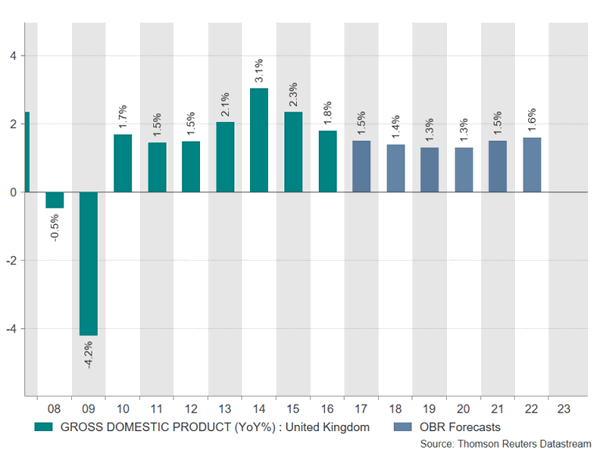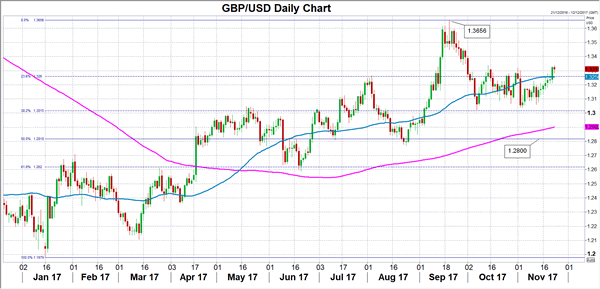The UK Chancellor of the Exchequer, Philip Hammond, unveiled his 2017 budget in parliament on Wednesday, which put the focus on investing for the future as Britain readies to leave the European Union. With the Conservative government still trying to bring under control a financial crisis era debt hangover, Hammond had little room for big giveaways. Instead, Hammond used his first budget after the disastrous June elections to plan for the future, with the housing market and business investment taking centre stage.
After an embarrassing U-turn on plans to raise national insurance for self-employed individuals in his Spring Budget statement, Hammond could not afford another blunder, with his unpopularity among the Brexiteers within the cabinet adding to the pressure. But it’s not just the finance minister’s credibility at stake with this budget as May’s government badly needs a win with British voters following the dramatic rise in popular appeal of the Labour leader, Jeremey Corbyn, during the election campaign. Also at stake is the UK’s economic credibility internationally as the country’s reputation has come under scrutiny following the 2016 referendum decision to exit the EU.
The budget got off to a negative start in forex markets as the pound fell after the Chancellor revised down the government’s forecasts for UK growth for 2017 and the next five years. The Office for Budget Responsibility (OBR) lowered its forecast for 2017 growth from 2% to 1.5% and for 2018 from 1.6% to 1.4%. The downward revisions were mainly on the back of weaker productivity growth in the UK, which have failed to recover after falling during the financial crisis.

Despite the reduced growth forecasts, Hammond has been given a bit of a boost from lower-than-expected government borrowing in the current fiscal year to date. The Chancellor’s first giveaway was to set aside an extra £3 billion to prepare the UK for all possible outcomes of Brexit. Business measures were high on the agenda as he allocated £500 million for a range of initiatives, such as the development of 5G mobile network and fibre broadband, and £540 million to support electric cars. There was also a £2.3 billion investment boost for research and development and a £20 billion fund for technology industries to help start-ups.
Transport projects also received more money with the creation of a £1.7 billion transforming cities fund and £300 million set aside to connect the High Speed 2 rail link with future rail projects in the North of England. Other winners included the devolved governments for Scotland, Wales and Northern Ireland, which were allocated extra funding, and there are plans to devolve more power to the West Midlands. The National Health Service also got a boost with an extra £2.8 billion announced for the NHS in England and a £10 billion capital investment package for hospitals.
There were some tax increases too, with owners of older diesel cars taking a hit, additional measures to reduce tax avoidance, and a plan to charge income tax on UK sales of multinational digital companies that are based in low-tax jurisdictions.
Hamond’s main headline grabber however, is the massive boost for the housing market. The government has come under pressure in recent years for not doing enough to support people climb on to the property ladder when average house prices have become unaffordable for many buyers. The government is committing £44 billion of capital funding for the housing market and new incentives to guarantee the construction of 300,000 new homes per year by the mid-2020s. The biggest surprise of the budget though was the announcement to abolish stamp duty for all first-time buyers of up to £300,000.
The UK’s leading share index, the FTSE 100, hit an intra-day high of 7460.91 (up 0.7%) after the budget speech, before heading lower due to a weak Wall Street to close up by just 0.1%. The pound recovered from a dip to $1.3211 on the weaker growth forecasts before climbing towards six-week highs above $1.33, as investors saw the budget as being overall positive for UK growth without comprising the government’s deficit commitment.
According to the OBR, the UK’s debt will peak at 86.5% of GDP in 2017 and will start declining in 2018. A balanced budget remains a long way off though given the negative impact of Brexit on growth and the government’s finances. Hammond’s predecessor, George Osbourne, was forced to abandon his target of eliminating the deficit by 2020 following the Brexit vote, but the deficit remains on track to being reduced to 1.1% GDP in 2022-23.
The forecasts and Hammond’s cautious spending plans should help the UK avoid any further downgrades to its credit rating. However, the projections are subject to the outcome of the Brexit talks as a crash exit from the EU could result in a further deterioration of public finances.
The Brexit negotiations did not get off to a very good start and the UK and the EU are currently in a deadlock, with the EU demanding that the UK settle the divorce terms before the talks proceed to discussing trade and a transition deal. There have been some optimistic signs recently amid reports that the prime minister, Theresa May, is now prepared to raise her offer of the Brexit bill from £20 billion to about £38 billion. This has raised hopes that a deal on the divorce terms could be reached in three weeks ahead of the EU summit in December.

The lack of breakthrough in December could send the pound tumbling again. The British currency has made an impressive recovery this year, gaining almost 8% versus the US dollar. It hit a 15-month high of $1.3656 in September but has been consolidating since amid the stalemate in the Brexit negotiations and the Bank of England following up its hawkish rhetoric with only a dovish rate hike. Yesterday’s budget is seen as slightly increasing the odds of further rate hikes over the next 2-3 years and might reassure investors about the UK government’s management of the economy.
However, the medium-term outlook will very much depend on what happens at the EU summit on December 14-15 as a further delay to an agreement for a transition period would only extend the uncertainty for businesses and further dampen confidence in the economy. Insufficient progress at the December summit could push the pound back towards $1.28, which is near the 50% retracement of the 2017 uptrend. A positive outcome on the other hand could bring the $1.40 handle into scope.












